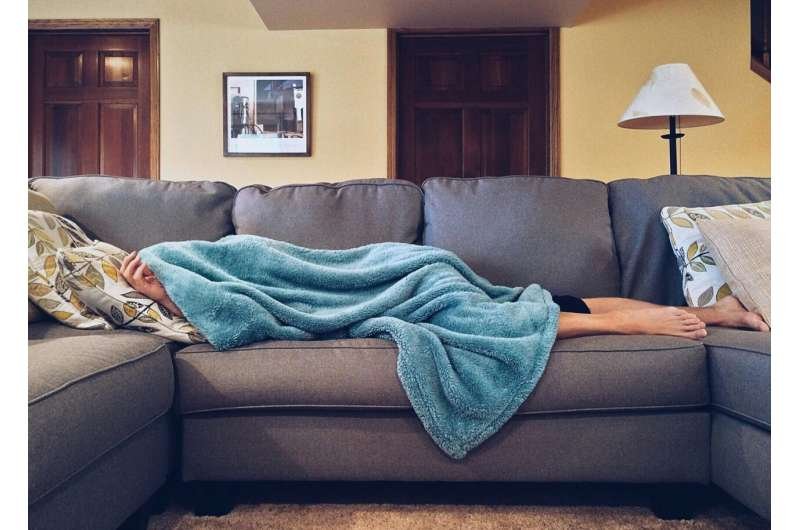
At the Center for Advanced Research in Sleep Medicine (CARSM), at Montreal’s Sacré-Coeur Hospital, Université de Montréal medical professor Shady Rahayel sees many patients with RBD.
“Normally, when we’re asleep and dreaming, our muscles are paralyzed, but around age 50, some people become very agitated during sleep and start punching, kicking and screaming,” Rahayel said, explaining the condition.
Unlike sleepwalking, which occurs during slow-wave sleep, RBD occurs during rapid eye movement (REM) sleep, he added. “It’s totally different. Sleepwalking affects younger people,” whereas RBD hits around middle age.
While it can be caused by taking antidepressants or by having sleep apnea, RBD is also a precursor of Parkinson’s disease and Lewy body dementia (LBD), two neurodegenerative diseases that belong to the same family.
To understand the progression of Parkinson’s and LBD, Rahayel is studying the distinct patterns of atrophy that RBD leaves in the brain. How does this atrophy begin and progress in people with RBD, and how can it predict the development of Parkinson’s and LBD?
His research team’s preliminary findings are set to be published in eBioMedicine.
‘Something is wrong’
RBD is an early warning sign that certain mechanisms in the brain are no longer working as they should. Nearly 90% of people with the disorder will go on to develop either Parkinson’s disease or LBD.
“The people with RBD who come to see us are in good health, but we know that something is wrong,” said Rahayel. “Of those who subsequently develop a disease, half will have Parkinson’s and the other half LBD.”
Having the second most common form of dementia after Alzheimer’s, “LBD patients are no longer able to function in everyday life,” said Rahayel. “As well as dementia, they will have Parkinson’s-like symptoms, vivid visual hallucinations, fluctuating attention and other symptoms.”
In search of a biomarker
CARSM researchers have access to the largest database of patients with RBD. But to find a biomarker with the help of AI, Rahayel’s computational neuroscience team needed even more MRI brain scans.
Tracking down the information, they contacted 11 sleep study centers around the world to assemble a database of 1,276 MRI scans of people at risk of, or with, Parkinson’s disease or LBD, and also of healthy people.
Using machine learning and computational models, the researchers identified two trajectories of brain atrophy progression.
“Normally, in a study of this type, you have to monitor the subjects annually and check the progression of the disease using brain scans,” Rahayel explained. “But this powerful algorithm can estimate the stage of progression of the disease based on scans of different people.”
Two trajectories
LBD seems to be associated with brain atrophy that begins in the cortex and then spreads to the interior of the brain, while in Parkinson’s the atrophy progresses from the interior to the exterior of the brain.
“The question now is why,” said Rahayel. The next steps will be to investigate the factors that lead to this deterioration in the cortex, such as vascular lesions, the effects of drugs and of lifestyle choices.
“Now that we have identified these new progression patterns, our goal is to be able to determine from an MRI whether a person has one of them so that we can provide the best possible care,” said Rahayel.
He would like to be able to apply the model in a clinical setting and define biological markers that are more reliable than clinical assessment, which can be influenced by external factors.
“If a person has just started a new medication, for example, this could influence their memory score on a cognitive test,” he observed. “Biomarkers are more objective.”
Rahayel hopes that a better understanding of how these diseases develop in the brain will support the search for more effective treatments.
More information:
Stephen Joza et al, Distinct brain atrophy progression subtypes underlie phenoconversion in isolated REM sleep behaviour disorder, eBioMedicine (2025). medRxiv: DOI: 10.1101/2024.09.05.24313131
University of Montreal
Citation:
Sleeping disorder may be an early indicator of neurodegenerative disease (2025, May 30)
retrieved 30 May 2025
from https://medicalxpress.com/news/2025-05-disorder-early-indicator-neurodegenerative-disease.html
This document is subject to copyright. Apart from any fair dealing for the purpose of private study or research, no
part may be reproduced without the written permission. The content is provided for information purposes only.

